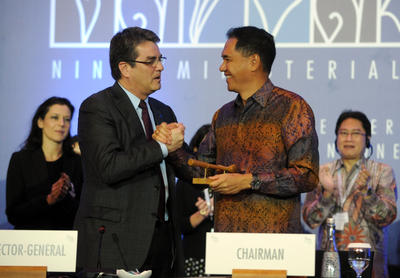New trade flows generated by the agreement are estimated to be between US$400 billion (as proposed by the OECD) and US$1 trillion (estimated by the Petersen Institute). The flows would create up to 21 million new jobs, 18 million of which will be in the developing world.
And the agreement has had wide support. Business lobbies were thoroughly disengaged throughout the Doha Round. But they threw their weight behind a package that promises to deliver more transparent, predictable and efficient customs procedures. Not only the United States, European Union and other OECD countries, but also two big beasts from the developing world, China and Brazil, gave full backing. African, Caribbean and Pacific countries, invariably defensive in the Doha Round, also came on board. Above all, success at the Bali conference is due to the new WTO director-general, Roberto Azevêdo. His deep technical knowledge of the issues and the negotiating process, and his consummate diplomacy, bridged divides that seemed insuperable in the run-up to and during the Ministerial. He now has a clear mandate to prepare a work program this year to tackle remaining Doha Round issues, and perhaps newer ‘post-Doha’ issues as well.
Two big question marks remain, however.
The first concerns the new agreement on trade facilitation. It is qualitatively different from most GATT and WTO agreements. The latter are mostly proscriptive. They contain ‘negative’ rules that reduce existing barriers, such as border tariffs and quotas. The trade-facilitation agreement, like the WTO’s Trade-Related Aspects of Intellectual Property Rights (TRIPS) agreement, is prescriptive. It elaborates ‘positive’ rules and procedures, not least on transparency, to enable speedier and less-costly customs procedures. But its disciplines are much weaker than those in TRIPS. They are also much weaker than trade-facilitation commitments in stronger free trade agreements, particularly those involving the United States. Implementation provisions are a case in point. Developing countries have wide leeway to implement the new WTO agreement, with long transition periods. How commitments might be tested and enforced in WTO dispute settlement is also moot. This raises questions about the ability of the agreement to deliver the advertised US$400 billion–US$1 trillion in new trade flows.
The second — and bigger — question mark concerns ‘old-style’ multilateralism — negotiations and final consent that involve the whole WTO membership. This method, in combination with Roberto Azevêdo’s masterful diplomacy, finally delivered a trade-facilitation agreement and (much more minor) agreements on agriculture and development issues. These are relatively low-hanging fruit. But can the same method unblock long-standing Doha Round logjams, especially on the key market-access issues of industrial goods, agriculture and services? And can it tackle post-Doha issues, such as investment, energy, competition rules and export restrictions?
It would seem not. Higher-hanging fruit require a new style of multilateralism in which negotiations take place among relatively small subsets of the WTO membership. Call it ‘plurilateralism’, ‘minilateralism’, ‘critical-mass decision-making’, ‘coalitions of the willing’, ‘WTO 2.0’ or whatever you like. Among the templates on offer are the WTO’s Information Technology Agreement and the Agreement on Basic Telecommunications Services, whose benefits are extended to the rest of the membership via the most-favoured nation (MFN) principle, its Agreement on Government Procurement, whose benefits are limited to its membership (conditional MFN), and the new Trade in Services Agreement being negotiated by 23 participants outside the WTO.
For new-style multilateralism to work, negotiations have to involve OECD countries plus a critical mass of emerging markets that together account for the bulk of relevant international trade. About 30 WTO members (counting the European Union as one) account for about 90 per cent of international trade. Ten members account for about 70 per cent of international trade. About 10 countries (again counting the European Union as one) account for 80 per cent or more of international trade in most services sectors. A future multilateral agreement on investment would have to be negotiated this way — that is, plurilaterally. For the WTO to consolidate and extend the gains from global value chains — the name of the game in early 21st-century international trade — it needs deeper agreements in industrial goods, services and investment. These can only be negotiated plurilaterally, preferably inside the WTO, but outside it if necessary.
Multilateralism needs to be revived at a time of stalled unilateral liberalisation, creeping protectionism in the wake of the global financial crisis, and a proliferation of discriminatory bilateral and regional trade agreements. Hence one or two cheers are due to the WTO after its Bali success. But old-style multilateralism still has its limits when it comes to plucking high-hanging fruit. The onus should be on plurilateral negotiations, preferably within the WTO framework. That is probably the best hope for trade multilateralism today.
Razeen Sally is Visiting Associate Professor at the Lee Kuan Yew School of Public Policy, National University of Singapore, and Director of the European Centre for International Political Economy, Brussels.

